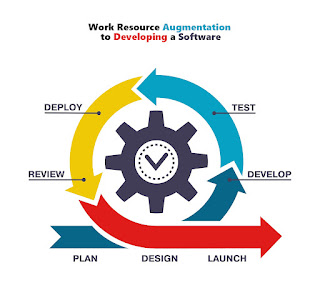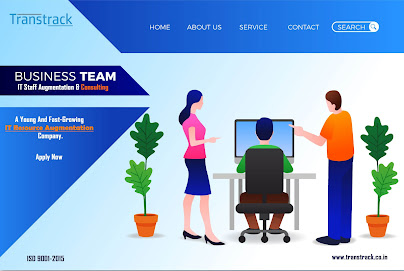 Introduction
Introduction
If you work in the software
development industry, you know that there's never enough time. The pace at
which technology changes are dizzying, and it can feel like every day brings
new challenges.
There are many ways to improve your team's efficiency and effectiveness
when developing software but resource augmentation is one of the best!
In this
article, we'll explain what resource augmentation is and how it can help teams
stay agile while developing their applications.
What is Resource Augmentation?
Resource augmentation is a way of increasing the
productivity of teams. It's a process that involves adding resources, such as
additional employees or contractors, to your team in order to increase their
output. This can be done in two ways:
·
First, by creating a new team made up of just
those who are already working on the project together. So if you have been
tasked with building an app and want someone else to help you build it you'll
need another developer on board! The second way would be by splitting up one team
into multiple smaller ones so that each member has more autonomy over what
they're doing within their own department (or division).
How resource augmentation can help teams stay agile when developing
software.
Resource augmentation allows
you to scale up and down as needed. This is especially helpful when developing
software, as it can allow teams to be more responsive to changes in demand.
When resources are underutilized, they can become less efficient and create
bottlenecks that slow down the entire team's ability to deliver on their goals.
Resource augmentation also allows for greater flexibility because it reduces
the need for reallocation across teams or departments within a single
organization.
In addition to helping stay
agile when developing software, resource augmentation is also beneficial for
other applications where there may be seasonal demands (e.,g., summertime
sports leagues).
In these cases, having more people on hand during peak times
may help prevent over-crowding at other times of the year when demand isn't so
high--thus allowing everyone who wants work done with their team members'
expertise rather than simply hiring temporary workers from outside sources
which would cost more money anyway (and may not even perform well enough).
A company's culture is an important factor to consider when adopting new
practices.
When it comes to adopting new
practices, culture is an important factor to consider. A company's culture is
how people work together and the set of values they hold dear. When you're
trying to adopt new software development practices, it can be tempting to
implement changes without considering the impact they'll have on your company's
overall culture.
The first step in this process
understands what exactly makes up your team's current working environment and
how it might affect your ability to adopt new technologies or processes. For
example:
·
Do employees prefer more hands-on work? Or are
they more comfortable delegating tasks?
·
Do workers have strong opinions about design
principles like "simplicity" or "usability"? This can have
an impact on whether or not everyone will buy into a given solution (or even
use one).
It's important to evaluate your team's needs and prepare for possible
changes.
As you begin to implement new
practices, it's important to evaluate your team's needs and prepare for
possible changes. Consider how your company's culture will affect the way you
implement new processes. Think about whether or not these new ways of working
are sustainable long-term. The success of each project depends on its ability
to adapt and evolve over time; therefore, it is critical that managers take
steps now so they can be prepared when their teams want more autonomy or
flexibility later on down the line!
Implementing new processes will improve the way your teams interact with
each other and with clients.
Implementing new processes
will improve the way your teams interact with each other and with clients.
- Reducing
time spent on communication: A well-designed tool can help your team communicate
efficiently; reducing the amount of time they spend sending emails back and
forth.
- Improving the quality of communication: The most important thing to do when improving
quality is to make sure everyone has access to all information at all times, so
you don't have any surprises later on in development or deployment. This can be
achieved by putting together a solid Information Architecture (IA) plan early
on in the project lifecycle, which includes how data will be stored on various
systems throughout development--and even after deployment! If there are major
changes made at any point along this path during development or testing cycles,
then those changes must also be reflected in an updated IA document as well as
any code changes made along these same paths later on down line (e.,g.,
V1->V2). This process helps ensure that no one forgets anything important
about their responsibilities within their specific departmental roles/functions
within larger corporate structures such as IT departments etc.
Resource augmentation helps companies do more with less.
Resource augmentation is the
process of adding resources to a team to increase productivity. This can help
teams stay agile when developing software, which means they can do more with
less. Resource augmentation also helps companies do more with less because it
allows them to maintain high-quality work and release products faster than
otherwise possible.
For example: If you were
working on an e-commerce site, but lacked developers who knew how to build out your
product from scratch (a) what would
happen if someone quit their job at lunchtime? Or (b) how would they keep up with all the changes that are happening
every day?
Conclusion
Resource augmentation can be a
useful tool for software companies to keep their teams agile and efficient. If
you're looking for ways to improve your organization's efficiency, look no
further than resource augmentation. It will help keep your team focused on the
work at hand while also keeping them engaged with each other and clients
through a variety of activities such as brainstorming sessions or code review
sessions.











